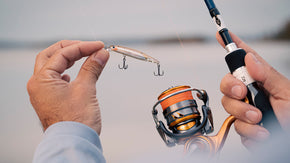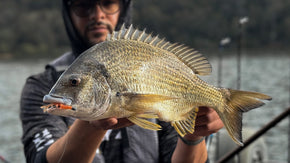Posted 16th May 2025
How to catch your first snapper


By Robert Thornton
With virtually all sportfish, the hardest one to catch is the first one. The humble snapper are certainly no different. Preparing the gear, applying the information you’ve read and watched, sorting through the advice you’ve been given – they all become pieces of a puzzle. The last piece, of course, is that beautiful snapper you’ve been chasing sitting in the landing net. Success!
Snapper are not known as a difficult adversary in general, but there are a few misconceptions about them that can point hopeful anglers in the wrong direction, or give them the wrong idea. Additionally, there is a tendency to overthink fishing, and I see this a lot with snapper.
In this piece we will hopefully dispel a few of these snapper myths, and hopefully show you that that if you want to catch your first… there really isn’t much to it!
Snapper: the facts
A lot has been written about snapper – in fact, they’re probably one of the most publicised fish in Australia! To learn a bit about the science and politics behind these fish, you can check out my beginner’s guide to catching snapper on lures. In this blog however, we will establish a few things that first-timers may not know about these awesome fish. Firstly, snapper are not just a southern fish. Despite strongholds in temperate waters across the bottom of our continent, their natural range actually extends well north of the tropics – especially on the East Coast! Communities in Central and North Queensland enjoy a seasonal run of ‘knobbies’ (a Queensland colloquialism) through the cooler months.
Secondly, snapper aren’t always found in deep water. While some (particularly larger specimens) spend a lot of their time around deep water structures offshore, environmental triggers like floods, big seas and favourable water temperatures often see them moving into bays, inlets and estuaries. In fact, snapper will sometimes hunt in depths shallow enough to wade, with fisheries like Shark Bay in WA, Moreton Bay in QLD and most of the North Island in New Zealand known for this phenomenon.
Thirdly, heavy tackle is not usually a necessity. Obviously, when chasing big fish with specialist techniques around cover, sturdy tackle is preferable, but for nailing that first red, scaling the weaponry back a little may actually work in your favour. Snapper fight hard – there’s no doubt about that! – however given most initial encounters are with fish between 30-50cm, a standard ‘estuary’ set-up is fine. Furthermore, despite being a structure-orientated fish, they will often run away from cover when hooked, and their runs can be directed with clever use of rod angles. If you need more convincing, a finesse approach will almost always get more enquiries, as snapper have very good eyesight and lighter lines allow a more natural presentation with baits and lures.
Lastly, rigs, lures and flies don’t need to be anything fancy! Snapper may be hyper-aware of what’s going on around them (this is why finesse techniques work so well), but this doesn’t mean they’re fussy eaters. Their diet includes a plethora of fish, crustaceans, molluscs and other invertebrates, and sometimes even sea birds! If you can get something edible in front of one without spooking it first, chances are it will bite!

HOW TO CATCH SNAPPER
Snapper can be fooled with a wide variety of techniques, so there’s probably no need to learn anything drastically new. As for locations, so long as there is some structure and/or hard bottom, as well as something for them to eat, there’s no reason why snapper won’t be there at some stage of the day, tide or season!
Bait techniques
Snapper will take most baits, with pilchards, squid strips, fish fillets, prawns or any other oily and scent-rich offering good enough for most reds. Live baits can work well too, especially if a big specimen is on the agenda!
Baited paternoster rigs deployed over any piece of hard structure in deep water are a pretty sure bet. Most wrecks, ledges, rubble patches and other pieces of hard structure in 5m or more – in a bay, gulf or offshore – will almost always hold snapper (amongst other things). Paternosters work well in water deep enough that a boat passing over the snapper doesn’t spook them, as with any vertical technique. Traces between 20-40lb (depending on the average size for the area) are fine, and hooks should be kept in the no. 2-3/0 range. Suicide, octopus and circle style hooks are all popular bait hooks for snapper.
In shallower water, where vertical fishing isn’t an option, or to coax a larger fish from the bottom, floatlining is a highly effective bait fishing technique. Floatlining involves fishing a dead bait with a running ball sinker rig adjacent to the boat, however the sinker is kept light enough for the bait to very slowly make its way toward the bottom. In this way, it spends a long time wafting around mid-water to hopefully catch the attention of a larger fish. Good-quality overhead reels loaded with monofilament are ideal for floatlining, as they allow the bait to naturally drift with the current while out of gear as the buoyant mono helps keeps it off the bottom for longer. The Saltist Overhead range is great for both bottom bashing with paternosters and floatlining. If you prefer spin tackle, the Free Swimmerreels with their Bite’N’Run tech features are worth looking at. Spinning tackle is also a better choice if using lighter line.
Lures
As with bait selection, lures aren’t something to spend too much time thinking about. Soft plastics are popular because they can be fished at different depths, are highly customisable and can be fished actively on the cast or vertically with minimal effort. Some anglers will even stick their rod in the holder and let the wave action work the soft plastic for them!
Inshore and estuary fisheries with smaller fish are best approached with smaller offerings, with the Bait Junkie Risky Critter, 3” Prawn, 3” Wave Minnow and 2.95” Flick ideal for 2-6m depths. Matched with a 1/12, 1/8 or 1/6oz Bait Junkie Finesse Jighead in #2, this is a deadly finesse presentation!
Plastics in the 4-7” range are a better pick for deeper water, especially around offshore structure. The Bait Junkie 5” Prawn, 4” Grub, 5.5” Wave Minnow, and 5 and 7” Jerkshad are the way to go in the deep, but must be matched with heavier jigheadsin the 1/2-2oz range. Other artificials like soft vibes, metal jigs, flies and hardbodies also work.
Casting and jigging aren’t the only ways to lure fish for snapper either. Trolling can be very effective, and using this technique to cover an expanse of good-looking ground or to skirt the edges of a prominent reef can yield surprising results! Trolling speeds between 3-6km/h are ideal, with suitable lures being anything that dives to mid-water depths – anywhere from about one third to two thirds of the way to the bottom. The Monster Rollin’ Crank and Spike 53EXDR are good trolling lures for inshore and estuary environments, with the Double Clutch 115EXDR and Current Master 93EXDR better in bays and offshore.

Land-based snapper
The idea of catching snapper land-based might seem strange, however in the right conditions it’s a perfectly viable goal. Piers, jetties, breakwalls, headlands and even beaches can all be good vantages for this pursuit, but you’ll want favourable conditions.
It may sound counter-intuitive, but things like cloudy skies, dirty water, rough seas and strong onshore winds are what bring snapper and close to shore. Big snapper especially love turbulence and low clarity when feeding in the shallows, and any land-based snapper devotee knows that when things turn bad outside, it’s time to don the Rainmax Stretch Jacket and head out!
Lures and bait work from the shore, but a few minor adjustments are in order. Paternosters and other weighted bait rigs are popular in calmer conditions when the fish aren’t in close, with heavier weights allowing the angler to cast out to deeper water where the snapper will be. Alex Bellisimo has written a blog on this technique already, and you can read it here.
Unweighted baits are dynamite in the shallows when things are really stirred up, however feeling for bites takes lots of skill, especially in windy, rainy and generally low-visibility conditions!
If using lures, soft plastics are once again a firm favourite. Bright coloured softies work best when things are rough, dark and dirty, and often you’ll be able to get away with heavier jigheads (which will help with casting distance) and heavier lines. Heavier lines won’t be detected as easily by snapper in turbulent conditions, and are handy when hooking big fish around jagged terrain in the shallows. I know I said you don’t need heavier gear, but there are circumstances when you don’t have much choice!
Join the red army
Once you catch your first snapper, you’ll understand why these fish have such a cult-like following. With their impressive growth potential, amazing fighting ability, stunning looks and 5-star eating qualities, it’s little wonder they’ve earned this status among Aussies.
Don’t let things like not having a boat or living in the tropics stop you from enjoying these awesome fish! They are available in every Australian state and within reach of virtuslly anyone with access to tidal water.
















